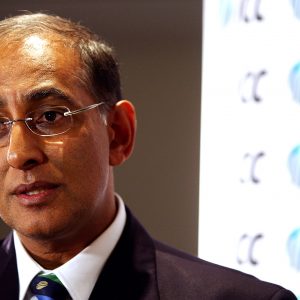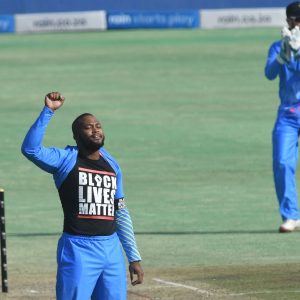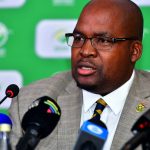Long Read | Part two: The start of CSA’s downfall
The board’s inability to rein in Thabang Moroe played a critical part in the organisation’s downfall, highlighted by a dark episode of revoking the accreditation of journalists critical of the cric…
Author:
26 October 2020

“To the team!” This is what the Protea Fire campaign that brought us closer to the senior men’s side used to scream. That team mantra clearly didn’t reach the office, as the collective spirit eroded in the administrative element of Cricket South Africa (CSA).
Several long-serving employees have told New Frame of feeling like islands, alone to their struggles and insecurities. Those that have eventually left the building have not done so quietly. The Commission for Conciliation, Mediation and Arbitration (CCMA) offices know those who represent CSA well, because they have become such regular defendants against disgruntled former employees. In fact, there are still cases freshly marked “CSA” in the CCMA’s in tray.
Former employees claim that working inside the walls of CSA in the past few years comes with an almost daily exposure to a toxic cocktail of backstabbing, bullying and belittling in the business. With such a wicked culture of distrust, it is no surprise to see the regular – and damaging – information leaks that have come out of the organisation, especially in the past year.
It wasn’t always this desperate, not always this despicably distant and devoid of that priceless sense of teamwork that the game underpinning the organisation seeks to emphasise on the field.
In May 2017, CSA and its associate partners swept the board at the annual Sport Industry Awards. Breakthrough technical sponsor New Balance claimed Best New Sponsorship, Campaign of the Year, Best use of PR and Brand of the Year for its work with the Proteas.
Audi received Creative Activation of the Year for its Bowling Lab initiative, and the catchy Fireball music video, complete with Faf du Plessis on lead vocals, won production company T&W the Commercial of the Year award.
The game was fun, profitable and cheerful about the future.
Related article:
Most ironically, then chief executive Haroon Lorgat won the Leadership in Sports Business category, a veritable acknowledgement by the industry that his work – and that of his organisation – was on the right trajectory. Little did Lorgat know that he was entering the last five months of his employment at CSA and this sea of goodwill was about to whip into a frenzied hurricane of self-harm.
The comments of CSA president at the time, Chris Nenzani, did not age particularly well. “It is a highly satisfactory reflection on the standards CSA is setting and the dominant role it is playing in the corporate world,” he said to the award winners. “It’s great to be acknowledged by industry experts and we are proud that an organisation like CSA is able to generate great value and returns to our commercial partners and agencies.”
Muslim Cabal
Shortly after that, Nenzani and his board turned their back on the very chief executive who had been so lauded just months earlier, throwing the organisation and its reputation into disarray. Lorgat left, and those in his wake had to pick up the considerable pieces.
Anyone who was seen to have been “team Haroon” or part of what was viciously labelled the Muslim Cabal faced an uncomfortable future.
Thabang Moroe took over as the acting chief executive in late 2017, before his permanent appointment in 2018. According to several personal accounts and the damning forensic investigation that led to his eventual dismissal, Moroe was a law largely unto himself. Despite a clear media policy that had been drafted in 2015 and approved by the board, Moroe would often adopt an ad-hoc approach to media engagements.
The board, the only power that he should have been answerable to, did little to dissuade the new leader. And so, brazenly, on he went.
The communications department, hitherto functional and familiar with the lay of the land, was often left in the dark, reading quotes attributed to the chief executive at the same time as the public. It was unnecessary, unmanageable and, most apparent, a blatant disregard for a department that was increasingly under pressure to restore the image of the organisation.
Moroe would confirm his attendance at sponsor engagements or be penned down as a speaker or an honoured guest, only to change tack and leave the organisation privately scrambling and publicly embarrassed.
Still, the board did little to rein him in.
Related article:
Moroe and Naasei Appiah, who had been promoted to the position of chief operating officer by that point, even took a trip to India without informing their communications department, leaving staff scrambling as sound bites from Mumbai popped up on airwaves and social media.
As he settled into his permanent role, Moroe was particularly bullish about the future prospects of the Mzansi Super League (MSL), the vastly watered down response to the failed T20 Global League of 2017. After flirting with the likes of Star Sports and SuperSport for the T20 Global League broadcast rights, the CSA came to an agreement with the SABC to flight the inaugural MSL season.
The broadcast and digital rights were awarded to Singapore-based Global Sports Commerce, an alliance that has since been investigated in the forensic audit that finally felled Moroe. The initial deal with Global Sports Commerce was extended to 2023 last year, with Moroe endorsing the company’s international credentials in spite of no major sponsors sharing the same level of optimism.
SuperSport took a dismissive stance on the tournament. As it was not to be shown on its channels, it continued as if the MSL didn’t exist. There was no mention of it on its news bulletins or cricket talk shows. There was a complete blackout, and any contract workers who took up MSL gigs faced uncertain futures in terms of working for one of the world’s biggest sports broadcasters again.
Like many in his organisation, Moroe must have had sleepless nights ahead of the first match in Cape Town, with many curious observers waiting to see just what would be served up. Would the lights come on? Would the cameramen, who had been negotiating their daily rates until the eve of the opening match, press the red button? Who would the commentators be? Would any spectators show up?
After the failure to launch just a year before, the trepidation was understandable. As the sun fell over Cape Town, Dale Steyn ran in and delivered the first ball in MSL history to the godfather of T20 cricket, Chris Gayle. After all the hysteria of the previous 15 months, it was a minor miracle that the ball itself was an innocuous dot ball, the mighty West Indian shouldering arms as sighs of relief swept through the presidential suite.
An MSL positive
The international stars still trickled in. Gayle was joined by Dan Christian, Rashid Khan, Samuel Badree, Asif Ali, Jason Roy, Jeevan Mendis and England captain Eoin Morgan, among a clutch of T20 hired guns. Added to the Proteas and a pile of prospects eager to catch the eye, it made for interesting cricket viewing.
One massive positive to come out of the tournament was the rise to prominence of the likes of Rassie van der Dussen, Lutho Sipamla and Anrich Nortje, who all acknowledged that the MSL changed their lives.
“That is why this tournament is so important,” Moroe said at the time. “It has given opportunities to players like Rassie and Anrich, who will hopefully go on to much bigger things. This tournament will give us greater depth from which to pick future Proteas.”
Van der Dussen would go on to play for the Proteas in all formats, including going to the 2019 ICC World Cup in England. Nortje missed the showpiece through injury, but he went on to become a Test player and has since become an Indian Premier League star, too.
Related article:
The overall product lacked varnish, though. What sponsors were there acquired their slice of Mzansi pie at knockdown prices, capitalising on a desperation that was readily apparent. Sportsman’s Warehouse saw its opportunity and pounced as a shirt sponsor. It was a world away from international giants such as Indian tyre manufacturer MRF and Emirates Airlines, who had reportedly expressed keen interest just a year before.
For Moroe, though, the launch and culmination of the first edition of the MSL was a shot in the arm, proof of what could be done. At this altitude of optimism, he came up with a simply incredible claim. Speaking exclusively to TRT World, an international news broadcast channel, Moroe stated that the MSL had a bright future and, in fact, he had just received two “very serious” proposals for sponsorship worth R500 million. Each.
He said it so matter-of-factly, so casually, that it seemed impossible to have been made up. “We will make an announcement in the coming months, but definitely before June,” he said from the confines of the CSA’s gleaming new offices.
To this day, neither of those proposals has ever been mentioned again. Quite why they were mentioned remains a mystery, especially if there was no substance to his claim.
As would become apparent, the claims were consistent with Moroe’s dealings around the MSL. He was overly optimistic, even at the risk of delusion. Under his watch, CSA had done little to tie up the T20 Global League loose ends that remained, leaving those franchise owners flabbergasted. It was as if that passage of time had never occurred.
The Hong Kong owners of the Bloemfontein Blazers were particularly stung by CSA’s callous attitude.
“We remain committed to the T20 Global League just as we were three months ago. We will be working towards the first edition scheduled for November 2018 with renewed vigour and enthusiasm,” Sushil Kumar, the principal owner of the Blazers, said on 10 October 2017.
Despite the postponement, there was still hope that the tournament could be salvaged. CSA then said little to the franchise owners for four months, traversing an explosive summer of cricket against India and then Australia, the latter series culminating in the unforgettable Sandpapergate scandal for the Australian team.
League owners left in the lurch
Against this backdrop, invested owners were still looking at ways of making the Global League a success. On 24 February 2018, during the T20 international between South Africa and India, Kumar had gone to Cape Town and met with Moroe, looking for answers about the future of his investment.
He even suggested that it might be better to outsource the tournament to entities that were willing to invest and run the tournament for profit. CSA was noncommittal to these opinions, and that indecision did little to quell the growing fears of the franchise owners. Running out of options, the Blazers owners requested a full refund for all their deposits and expenses on 29 March 2018. Kumar even flew back to South Africa in May that year, requesting an audience with the CSA to discuss the refunds owed to his company.
“My email to CSA and my message to Chris Nenzani seeking an audience went unresponded,” Kumar explained. He arrived in Johannesburg on 20 May and was told by the audit department that they would meet two days later. At that meeting, however, Kumar was amazed that there was no one from the executive. He was referred to independent director and audit and risk committee chairperson Louis von Zeuner if he had any further queries.
After an initial outlay of about $4 million, and a commitment to spend upwards of $100 million developing the city of Bloemfontein into a sport mecca, the blatant disregard stung Kumar deeply. “It was quite an embarrassment for us to keep pushing CSA just for an audience, having travelled all the way from our home country just to resolve issues which were never caused by us.”
Kumar and his City Sports group had been attracted to Bloemfontein by the scale of the land and the integrity of the people. Coming from Hong Kong, where just about everything is built up, they were excited at the prospect of establishing roots and investing in the development of a city that other franchise owners had shunned for the brighter lights of Johannesburg, Cape Town and Durban.
Related article:
He had already developed a relationship with the Mangaung Metropolitan Municipality, and had started getting quotes from South African companies for projects regarding development. They were fully invested, in heart and in pocket, and the dismissive tone that the CSA board and executive took with them was a particularly bitter pill to swallow.
“We are definitely disgruntled at the way CSA has handled, or mishandled, its affairs with regard to the T20 Global League. Bloemfontein was our first-choice city, and we had foreseen and planned a 12-month and 10-year plan for development of cricket at grassroots level,” said Kumar.
“We had also forged a relationship with Free State officials such as Zola Thamae, Johan van Heerden, Marina van der Walt and Xander Snyders, among others, in the past year. It is disappointing that all the hard work done by all of us has gone down the drain.”
The money was refunded, but the bitter taste lingers to this day. Moroe and his merry board of brothers boldly carried on, leaving the turmoil of failed ventures in the rear-view mirror. They hoped that Proteas coach Ottis Gibson and his team would assuage some of the pressure with a successful World Cup campaign.
Alas, South Africa went from bust to dust. They were bruised by England, bloodied by Bangladesh and then bullied by India. They were eventually bundled out by the Black Caps and eliminated at the group stage, with precious few reputations enhanced in the process. It was a bleak summer, but it was merely a warning of what was to come – on and off the field.
Gibson’s future was up for debate and Moroe added to the confusion by stating his desire to play a role in future team selections. Gibson soon left the building and Enoch Nkwe was hired as interim coach, while the team shed much of its golden generation.
Sponsors who were already getting twitchy played their cards close to their chests when it came to renewing their ties, aware that this was a team and an organisation in rapid rebuilding mode. The media, who had watched as a carefully constructed PR profile was cast aside for braggadocio and bombast, started asking more pressing questions.
Fights with the media
There was a mounting battle with the players’ union, the South African Cricketers’ Association, over unpaid commercial fees from the 2018 MSL. The union was considering a strike and the matter went all the way to the Johannesburg high court.
That matter eventually led to the November 2019 suspension, for a dereliction of duty, of interim director of cricket Corrie van Zyl, Appiah and head of sales and sponsorship Clive Eksteen.
Instead of engaging the media, Moroe turned on journalists. Thamie Mthembu was hired as the head of communications and he came in as subtly as a beamer from a tearaway fast bowler. His immortal question of why the media or the public needed to know who would be coach or selector of the national team will live long and lamentably in the memory, even though he now denies ever saying such a thing.
Mthembu’s reluctance to own his initial error is symptomatic of a culture of denial and delusion.
Beyond his own head-butts with the media, Mthembu was in the job for barely a month when Moroe performed his final, audacious act. Growing increasingly irritated at a media campaign that he felt was against the MSL, Moroe revoked the accreditations of five of the most experienced journalists in South African cricket. World cricket, for that matter.
Firdose Moonda (ESPN Cricinfo), Telford Vice (then Times Media, now Cricbuzz), Neil Manthorp (a freelancer and SABC commentator), Stuart Hess (Independent Media) and Ken Borland (The Citizen) had their access to the press box halted for a period during the 2019 MSL tournament, for writing negative stories about the CSA.
Related article:
In each case, the staff at cricket grounds were instructed to make sure the journalists knew they could acquire a ticket to the ground like normal spectators. The revocation came even after several, private warnings to the organisation against doing so. The damage was done, and Moroe then went on national television and radio, taking full ownership of his decision to do so.
He was a law unto himself. Or, to use the words of an employee who worked under him, “an unstoppable tsunami”. The accreditation debacle exposed a petulant and childish streak in the company. The reports around the MSL were concerned with the commercial sustainability of a product that, for all intents and purposes, was simply a different version of the RAM Slam T20 competition that already existed in the contractual obligations of all domestic players.
The media were questioning the financial sense of the MSL, bankrolled by CSA coffers that were bleeding more than they were gleaning without title sponsors or a lucrative broadcast deal. None of it made sense, but pointing out that obvious concern was supposedly tantamount to treason.
An organisation in free fall
Sponsors and other stakeholders immediately voiced their dismay at the way Moroe and CSA were handling their affairs. Standard Bank, who had a deal worth R100 million a year with the CSA, didn’t pull its punches.
“Standard Bank is committed to upholding the highest levels of leadership, integrity and governance. In light of recent developments at CSA, which are a culmination of long-standing problems which have damaged Standard Bank’s reputation, it has decided not to renew its partnership with CSA,” group chief marketing and communications officer Thulani Sibeko announced.
Momentum, a long-standing sponsor of R30 million a year and a friend of the game, issued an ultimatum that included the resignation of the board and the institution of a forensic audit before 30 April 2020. Sunfoil, which operated within the Willowton Group, also issued an ultimatum and called on Moroe and Nenzani to resign immediately.
Board members Dawn Mokhobo and Shirley Zinn, as well as board chairperson and finance committee head Iqbal Khan, resigned within days of each other, citing corporate governance concerns, objections to the ban of journalists and concerns over malpractice and credit card abuse at CSA.
The organisation was in free fall and Moroe was forced to call each of the journalists and apologise, privately disclosing the significant pressure he was under. Heavy lies the cricket crown, and all that.
It was too little, too late. He had alienated himself from public sympathy, ran roughshod through employee relations and now even the previously stone-like board had a stick with which to beat him.
Former cricket chief Ali Bacher joined the public chorus of concern, saying Moroe should resign as he was out of his depth.
“We are currently the joke of world cricket,” Bacher told Cricinfo at the time. “I don’t want us to end up like the West Indies, who were once a mighty cricket nation but have just disappeared over the last decade or two.”
Cricket was truly at a crossroads, and the game had to act. Moroe was eventually suspended on 6 December 2019, but his tsunami of a time had done considerable damage. And like all others who had been dismissed before him, the embattled chief executive would not go without a review.
There has been a spate of resignations within a board that finally started showing cracks. On 26 October, CSA confirmed that the entire board was asked to resign, and they all did following the other resignations that had happened in dribs and drabs.
But before that mass walkout, there was considerable water under the bridge.
The third and final instalment of this three-part series on the CSA’s downfall looks at the emergency team assembled to save the game in December 2019, the effects of Covid-19 and the Black Lives Matter movement, government interventions, and the legacy of Chris Nenzani and the board that allowed things to get this bad.





